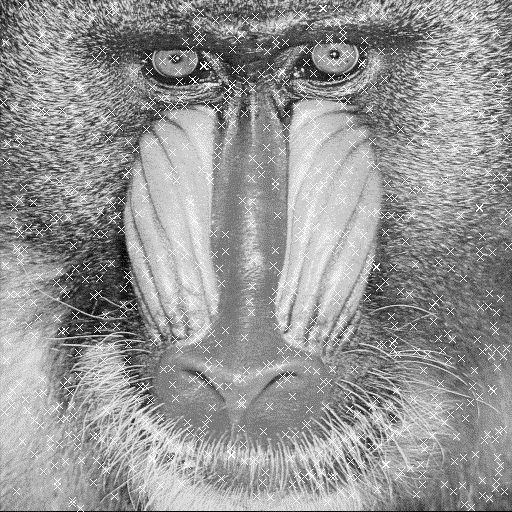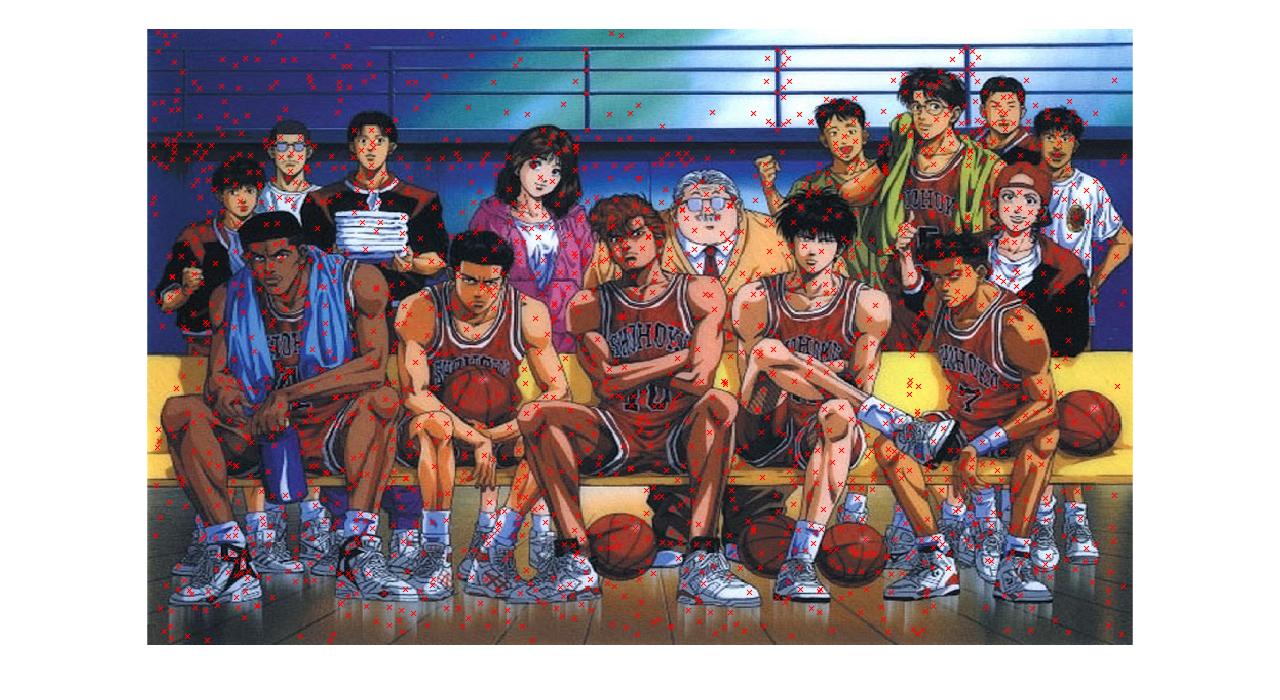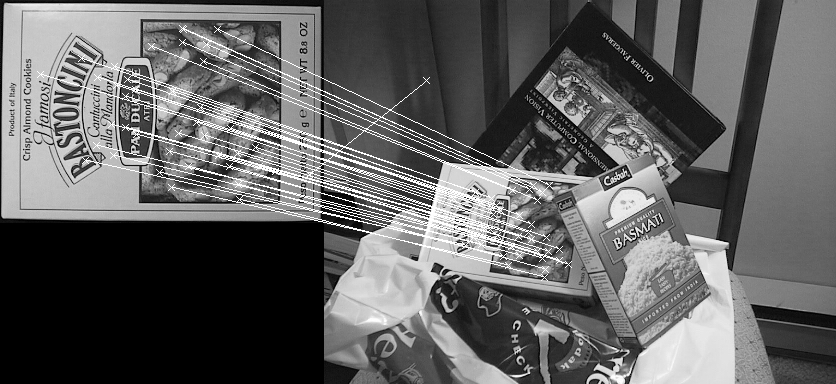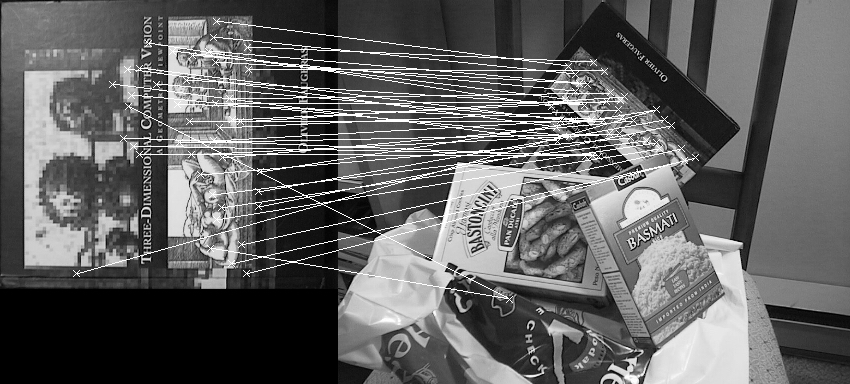VLFeat wrapper
The keypoint detector and descriptor classes implemented are a wrapper of the amazing vlfeat functionalities. There are three separated classes, they are:
- Keypoint
- member variables: coords_, scale_, orientation_, index_, color_, keypoint_type_
- member methods: setters/getters
- Detector
- detect_keypoints
- Descriptor
- extract_descriptor;
The specific keypoint class is the subclass of both Detector and Descriptor.
Results of Detector


Detection results returned by the implemented C++ wrapper


Detection results returned by the SIFT Mex file
Results of Matching



SIFT feature matching results returned by the implemented C++ wrapper
Keypoint class: header file
The header file of the Keypoint class
#ifndef keypoint_h
#define keypoint_h
#include "numeric.h"
namespace open3DCV {
//! Keypoint class
/*!
* This class encapsulates the data associated with a 2D image keypoint.
* This class stores the x and y coordinates of the image location, along
* with the index (i) of the image (camera) it is found, and color value
* (stored in a 0-255 format).
*/
enum KeypointType
{
INVALID = -1,
DOG = 0,
HARRIS = 1,
SIFT = 2,
SURF = 3,
};
class Keypoint {
public:
Keypoint(const Vec2 &r_x, KeypointType &r_t);
Keypoint(const Vec2 &r_x, KeypointType &r_t, unsigned int r_i);
Keypoint(const Vec2 &r_x, KeypointType &r_t, unsigned int r_i, const Vec3i &r_c);
virtual ~Keypoint() { };
const Vec2 &coords() const;
void coords(const Vec2 r_coords);
const unsigned int index() const;
void index(const unsigned int r_i);
const Vec3i &color() const;
void color(const Vec3i r_c);
const double scale() const;
void scale(const double r_s);
const double orientation() const;
void orientation(const double r_o);
private:
Vec2 coords_; // coordinates
unsigned int index_; // Image index
Vec3i color_; // color
KeypointType keypoint_type_;
double scale_;
double orientation_;
};
// inline code
}
#endif // keypoint_h
Detector class: header file
The header file of the Detector
#ifndef detector_h_
#define detector_h_
#include "image/image.h"
#include "keypoint/keypoint.h"
namespace open3DCV {
class Detector {
public:
Detector();
virtual ~Detector();
virtual int detect_keypoints(const Image& image, vector<Keypoint>& keypoints);
};
} // namespace open3DCV
#endif
Descriptor class: header file
#ifndef descriptor_h_
#define descriptor_h_
#include "math/numeric.h"
#include "image/image.h"
#include "keypoint/keypoint.h"
namespace open3DCV {
class Descriptor {
public:
Descriptor() { };
virtual ~Descriptor() { };
virtual int extract_descriptor(const Image& image, const Keypoint& keypoint, Vecf& descriptor) = 0;
virtual int extract_descriptors(const Image& image, vector<Keypoint>& keypoints, vector<Vecf>& descriptors);
};
// If any descriptors could not be extracted at a given keypoint, that keypoint would be removed from the container
inline int Descriptor::extract_descriptors(const Image& image, vector<Keypoint>& keypoints, vector<Vecf>& descriptors)
{
descriptors.reserve(keypoints.size());
auto keypoint_it = keypoints.begin();
while (keypoint_it != keypoints.end())
{
Vecf descriptor;
if (!extract_descriptor(image, *keypoint_it, descriptor))
{
keypoint_it = keypoints.erase(keypoint_it);
continue;
}
descriptors.push_back(descriptor);
}
return 0;
}
} // namespace open3DCV
#endif
Sift detector class: header file
The header file
#ifndef sift_h_
#define sift_h_
#include "vl/sift.h"
#include "keypoint/keypoint.h"
#include "keypoint/detector.h"
#include "keypoint/descriptor.h"
namespace open3DCV {
class Sift_Params {
};
class Sift : public Detector, public Descriptor {
public:
Sift() { type_ = SIFT };
~Sift() { delete data_; };
int convert(Image &img);
int detect_keypoints(const Image &image, vector<Keypoint> &keypoints, int verbose);
int extract_descript();
void transpose_descriptor (vl_sift_pix* dst, vl_sift_pix* src);
static bool ksort(const Keypoint &a, const Keypoint &b);
vl_bool check_sorted(const vector<Keypoint> &keys, vl_size nkeys);
private:
vl_sift_pix* data_;
int width_, height_, channel_;
KeypointType type_;
}; // end of class Sift
} // end of namespace open3DCV
#endif // sift_h
Sift detector class: implementation file
int Sift::detect_keypoints_simp(Image &image, vector<Keypoint> &keypoints, int verbose)
{
// convert image
convert(image);
// sift setting
int O = 3;
int S = 3;
int o_min = 0;
double edge_thresh = 10;
double peak_thresh = 0;
double norm_thresh = -INFINITY;
double magnif = 3;
double window_size = 2;
VlSiftFilt* filt = 0;
if (filt == nullptr || (filt->width != image.width() ||
filt->height != image.height()))
{
vl_sift_delete(filt);
filt = vl_sift_new(image.width(), image.height(),
O, S, o_min);
vl_sift_set_edge_thresh(filt, edge_thresh);
vl_sift_set_peak_thresh(filt, peak_thresh);
}
int vl_status = vl_sift_process_first_octave(filt, data_);
keypoints.reserve(2000);
while (vl_status != VL_ERR_EOF)
{
vl_sift_detect(filt);
const VlSiftKeypoint* vl_keypoints = vl_sift_get_keypoints(filt);
int nkeys = vl_sift_get_nkeypoints(filt);
for (int i = 0; i < nkeys; ++i)
{
double angles[4];
int nangles = vl_sift_calc_keypoint_orientations(filt, angles, &vl_keypoints[i]);
for (int j = 0; j < nangles; ++j)
{
Keypoint keypoint(Vec2(vl_keypoints[i].x + 1, vl_keypoints[i].y + 1), type_);
keypoint.scale(vl_keypoints[i].sigma);
keypoint.orientation(angles[j]);
keypoints.push_back(keypoint);
}
}
vl_status = vl_sift_process_next_octave(filt);
}
return 0;
}